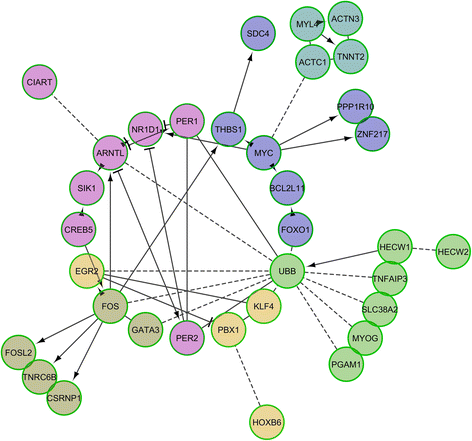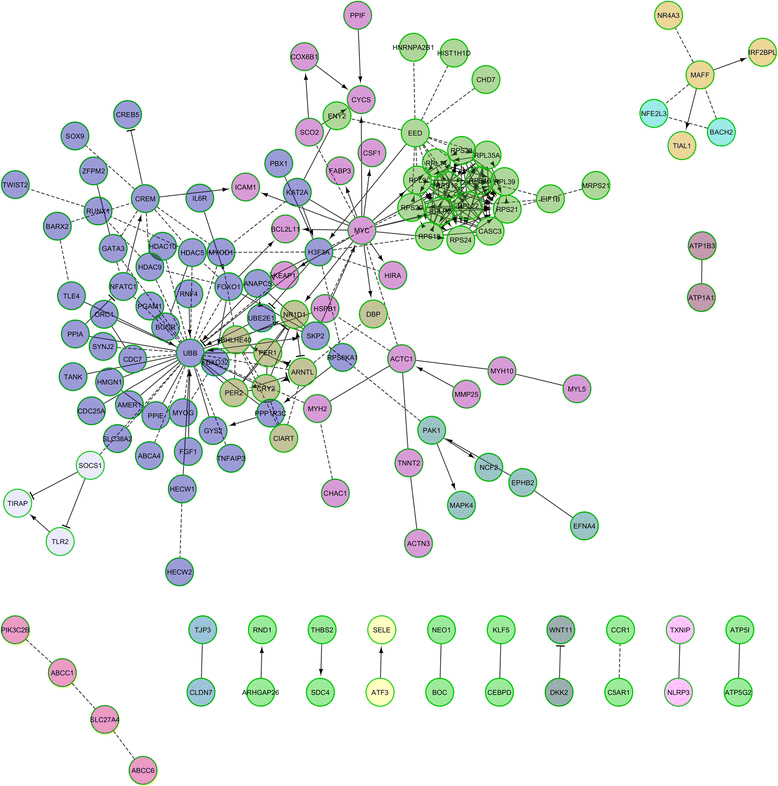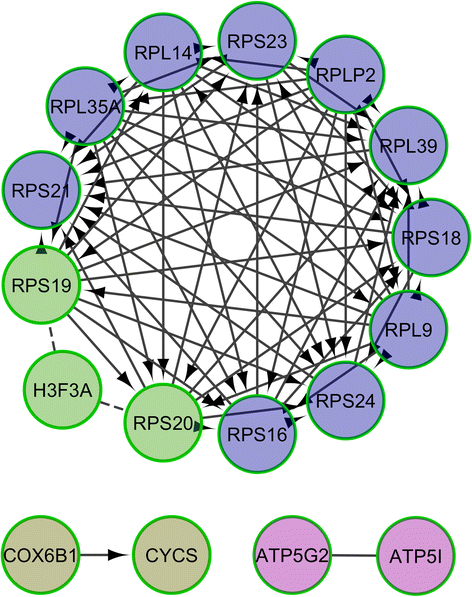Nutrient supply affects the mRNA expression profile of the porcine skeletal muscle
- PMID: 28797239
- PMCID: PMC5553784
- DOI: 10.1186/s12864-017-3986-x
Nutrient supply affects the mRNA expression profile of the porcine skeletal muscle
Abstract
Background: The genetic basis of muscle fat deposition in pigs is not well known. So far, we have only identified a limited number of genes involved in the absorption, transport, storage and catabolism of lipids. Such information is crucial to interpret, from a biological perspective, the results of genome-wide association analyses for intramuscular fat content and composition traits. Herewith, we have investigated how the ingestion of food changes gene expression in the gluteus medius muscle of Duroc pigs.
Results: By comparing the muscle mRNA expression of fasted pigs (T0) with that of pigs sampled 5 h (T1) and 7 h (T2) after food intake, we have detected differential expression (DE) for 148 (T0-T1), 520 (T0-T2) and 135 (T1-T2) genes (q-value <0.05 and a |FC| > of 1.5). Many of these DE genes were transcription factors, suggesting that we have detected the coordinated response of the skeletal muscle to nutrient supply. We also found DE genes with a dual role in oxidative stress and angiogenesis (THBS1, THBS2 and TXNIP), two biological processes that are probably activated in the post-prandial state. Finally, we have identified several loci playing a key role in the modulation of circadian rhythms (ARNTL, PER1, PER2, BHLHE40, NR1D1, SIK1, CIART and CRY2), a result that indicates that the porcine muscle circadian clock is modulated by nutrition.
Conclusion: We have shown that hundreds of genes change their expression in the porcine skeletal muscle in response to nutrient intake. Many of these loci do not have a known metabolic role, a result that suggests that our knowledge about the genetic basis of muscle energy homeostasis is still incomplete.
Keywords: Angiogenesis; Circadian rhythm; Oxidative stress; Pig; RNA-seq; Transcription factor.
Conflict of interest statement
Ethics approval
Animal care, management procedures and blood sampling were performed following national guidelines for the Good Experimental Practices and they were approved by the Ethical Committee of the Institut de Recerca i Tecnologia Agroalimentàries (IRTA).
Consent for publication
Not applicable.
Competing interests
The authors declare that they have no competing interests.
Publisher’s Note
Springer Nature remains neutral with regard to jurisdictional claims in published maps and institutional affiliations.
Figures




Similar articles
-
Comparing the mRNA expression profile and the genetic determinism of intramuscular fat traits in the porcine gluteus medius and longissimus dorsi muscles.BMC Genomics. 2019 Mar 4;20(1):170. doi: 10.1186/s12864-019-5557-9. BMC Genomics. 2019. PMID: 30832586 Free PMC article.
-
Analysing the Expression of Eight Clock Genes in Five Tissues From Fasting and Fed Sows.Front Genet. 2018 Oct 18;9:475. doi: 10.3389/fgene.2018.00475. eCollection 2018. Front Genet. 2018. PMID: 30405688 Free PMC article.
-
Role of AMPK signalling pathway during compensatory growth in pigs.BMC Genomics. 2018 Sep 17;19(1):682. doi: 10.1186/s12864-018-5071-5. BMC Genomics. 2018. PMID: 30223793 Free PMC article.
-
Effects of short-term fasting on the rhythmic expression of core circadian clock and functional genes in skeletal muscle of goldfish (Carassius auratus).Comp Biochem Physiol B Biochem Mol Biol. 2018 Dec;226:91-98. doi: 10.1016/j.cbpb.2018.07.006. Epub 2018 Aug 10. Comp Biochem Physiol B Biochem Mol Biol. 2018. PMID: 30099196
-
RNA-seq based detection of differentially expressed genes in the skeletal muscle of Duroc pigs with distinct lipid profiles.Sci Rep. 2017 Feb 14;7:40005. doi: 10.1038/srep40005. Sci Rep. 2017. PMID: 28195222 Free PMC article.
Cited by
-
Integrated transcriptomics and proteomics analysis reveals muscle metabolism effects of dietary Ulva lactuca and ulvan lyase supplementation in weaned piglets.Sci Rep. 2024 Feb 26;14(1):4589. doi: 10.1038/s41598-024-55462-2. Sci Rep. 2024. PMID: 38409238 Free PMC article.
-
Genetic variations (eQTLs) in muscle transcriptome and mitochondrial genes, and trans-eQTL molecular pathways in feed efficiency from Danish breeding pigs.PLoS One. 2020 Sep 17;15(9):e0239143. doi: 10.1371/journal.pone.0239143. eCollection 2020. PLoS One. 2020. PMID: 32941478 Free PMC article.
-
Transcriptome shifts triggered by vitamin A and SCD genotype interaction in Duroc pigs.BMC Genomics. 2022 Jan 7;23(1):16. doi: 10.1186/s12864-021-08244-3. BMC Genomics. 2022. PMID: 34991486 Free PMC article.
-
The Circadian Physiology: Implications in Livestock Health.Int J Mol Sci. 2021 Feb 20;22(4):2111. doi: 10.3390/ijms22042111. Int J Mol Sci. 2021. PMID: 33672703 Free PMC article. Review.
-
SUMOylation promotes survival and integration of neural stem cell grafts in ischemic stroke.EBioMedicine. 2019 Apr;42:214-224. doi: 10.1016/j.ebiom.2019.03.035. Epub 2019 Mar 21. EBioMedicine. 2019. PMID: 30905846 Free PMC article.
References
-
- Ayuso M, Fernández A, Núñez Y, Benítez R, Isabel B, Barragán C, et al. Comparative analysis of muscle transcriptome between pig genotypes identifies genes and regulatory mechanisms associated to growth, fatness and metabolism. PLoS One. 2015;10:e0145162. doi: 10.1371/journal.pone.0145162. - DOI - PMC - PubMed
-
- Khetarpal SA, Rader DJ. Genetics of lipid traits: genome-wide approaches yield new biology and clues to causality in coronary artery disease. Biochim Biophys Acta. 1842;2014:2010–2020. - PubMed
Publication types
MeSH terms
Substances
LinkOut - more resources
Full Text Sources
Other Literature Sources
Miscellaneous

